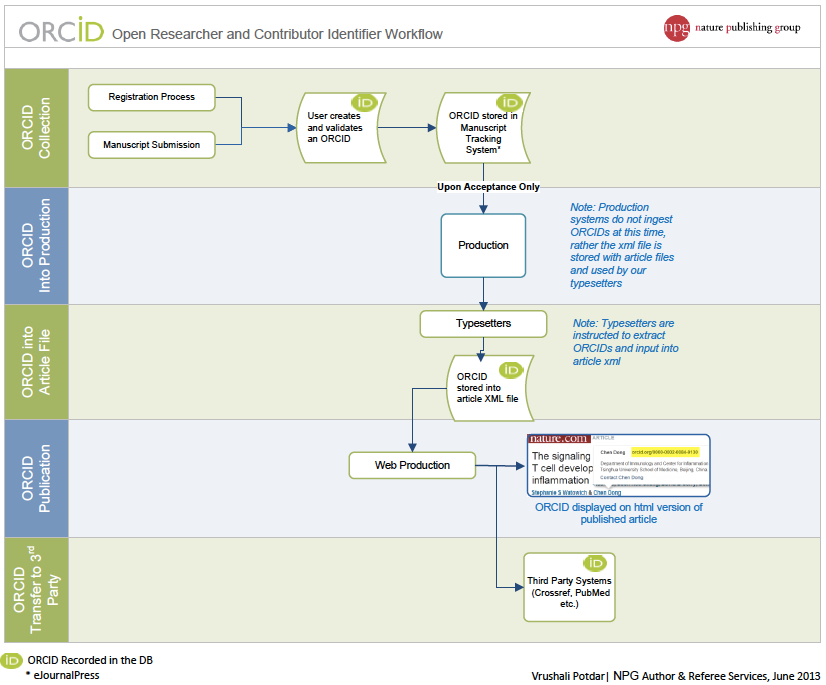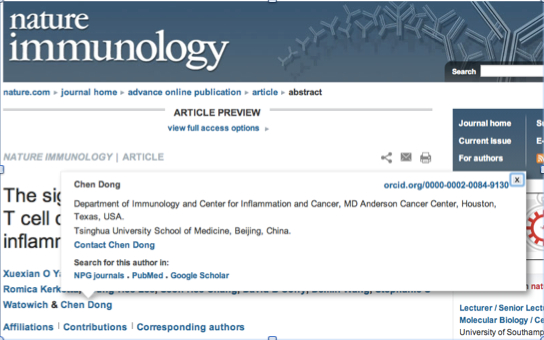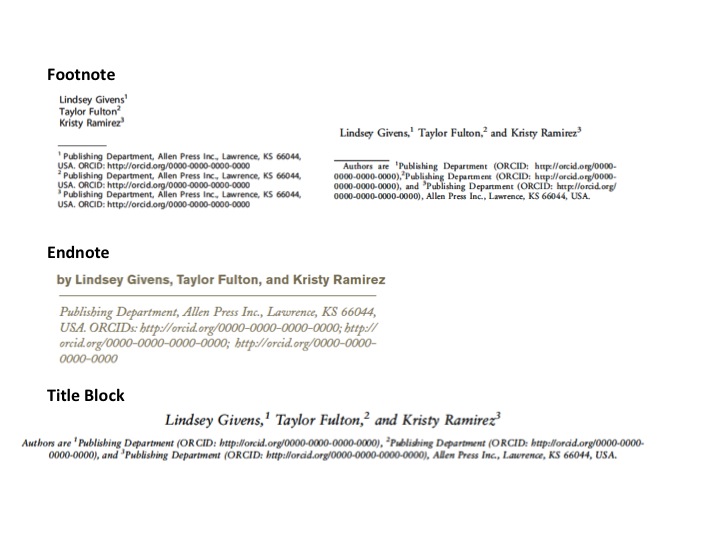For ORCID identifiers to become part of the metadata on published works, publishers must embed the identifiers in the submission and production workflow. Publishers including the American Physical Society and Copernicus have integrated ORCID identifiers into their author profiles, and vendors such as Aries, ScholarOne, and eJournalPress have integrated ORCID identifiers into the manuscript submission process. This is a great start in less than a year from the launch of the ORCID Registry. However, for the value of ORCID to be realized, ORCID identifiers need to be carried through the submission and production process.
How would this work? Many publishers use several systems to manage the submission, review, and production process. It is therefore important to document the entire workflow, from submission of a manuscript through to publishing and to submission of XML to CrossRef. We will be discussing integration of ORCID identifiers in two venues: during a Webinar on September 19, and at our Outreach meeting on October 30. As a prelude to these events, in this blog I am presenting current-state-of-the-art integrations and proposals for standard display practices. ORCID would very much like your feedback prior to and during these upcoming meetings as we develop recommended best practices for integration of ORCID identifiers by the publishing community. You may add comments at the end of this blog, submit iDeas to our Forum, and we encourage you to participate in the Webinar and Outreach meetings.
Integrating ORCID identifiers throughout the publishing workflow
Both Hindawi Publishing Corporation and Nature Publishing Group (NPG) have mapped their journal publishing processes and have implemented end-to-end integration of ORCID identifiers. Hindawi has been submitting ORCID identifiers as part of their XML submission to CrossRef since March, and NPG since June.
“Implementing ORCID identifiers into publishing workflows can present challenges, especially for publishers using multiple systems, but they are surmountable. NPG is a strong supporter of ORCID. The more authors that claim ORCIDs, and the more they are integrated into articles on platforms like nature.com, the greater the benefit to the research community,” said Tara Packer, Head of Author & Referee Services at NPG. She provided a schematic of their ORCID identifier workflow, showing the overall process and the interfaces between systems in the process flow. NPG had to navigate between their submission system vendor, production systems, and typesetters; develop web production display standards; and ensure that ORCID identifiers were included in the XML shipped to third party indexing systems such as CrossRef and PubMed.

Hindawi runs their entire submission-production process using in-house software. Paul Peters, Chief Strategy Officer at Hindawi, provided an overview of their ORCID identifier integration at the ORCID Outreach meeting in May, 2013. He commented that the technical integration was the easy part. Harder was the social aspect of integration: communicating with authors and co-authors about the benefit of registering for an ORCID identifier. Hindawi has dedicated considerable resources to contacting authors and encouraging them to register for an ORCID identifier. To date, their efforts have netted 20% compliance. Authors will likely see more reason to register as more organizations integrate ORCID identifiers. To help stimilate adoption, ORCID has stepped up efforts to communicate directly with researchers and scholars, including our recently launched Ambassador program. We also have been working to improve the user experience—both speed of registration and ease of importing works. Later this year, we will be enhancing our standards for collecting works metadata and launching an affiliations module. For their part, Hindawi will continue their efforts to work with their authors to encourage ORCID registration and addition of ORCID record data. “Everything we do is driven by data, ” explained Peters. “So, we need reliable author identifiers. But there can be no reliable author identifiers without ORCID.” They are also planning to link with other author identifiers and are integrating funding data using FundRef — more on this effort in a blog later this summer.
Display of ORCID identifiers in print and online.
An issue that both Hindawi and CrossRef have faced and addressed is how to display ORCID iDs in the published works. ORCID display guidelines call for display of a hyperlinked URI preceded by the iD icon:

But how does this translate to the written page? NPG chose to display the ORCID iD only in the online version of the published article, as a hyperlink from the author list. The first Nature paper with an ORCID iD was pubished June 2, 2013.

Tim Cross, Product Marketing Manager at Allen Press has shared these guidelines for the collection of ORCID identifiers in publishing workflows:
1. Determine a solution for incorporating ORCID iDs that works well with your current journal style.
2. Aim for making the ORCID iDs readable and useful. They should be easy to find and logically placed. See the images below for optimal display of ORCIDs in four common journal styles.
3. Ensure that each ORCID identifier is easily correlated with the appropriate author.
4. Remember that the source XML generating the output PDF will require the ORCID iDs to be linked to their associated authors.
5. Encourage all authors publishing in your journal to obtain an ORCID identifier. At a minimum, print the ones you do receive.
6. Add collection of ORCID identifiers to your manuscript submission process so that authors submit their ORCID iD when they submit their paper.
7. Establish a policy stating whether it is the responsibility of the author or the editorial office to verify that the ORCID iD is accurate before publication.
8. Add information on obtaining and submitting ORCID iDs to your Instructions for Authors.
His team has developed four sample displays for print journals, with proposed layouts for journals that display address listings in footnotes, endnotes, or in the title block

We welcome comments from the research community on these proposed standard display guidelines. We look forward to working with the publishing community during the Outreach meeting in October, 2013. One product of that meeting will be recommended best practices for integrating and displaying ORCID identifiers, and we encourage your participation in developing these guidelines.
